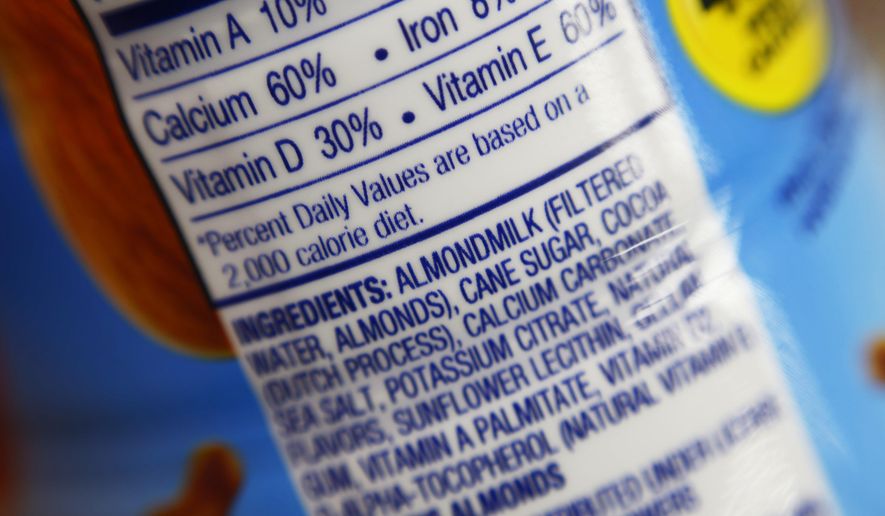OPINION:
Perhaps “What’s in a label?” would be an appropriate question to ask of a modern day Romeo and Juliet. Today’s grocery aisles are so covered by labels warning that soda is dangerous and barbecues will give you cancer, that any star-crossed couple is right to be confused about their real risk.
Presumably, labels exist to communicate accurate information about a product’s content and safety. But the Coalition for Accurate Product Labels reports that in the first half of 2018, 11 states introduced close to three dozen proposals for warning labels or ingredient disclosures that went beyond national standards, and in many cases exceeded the bounds of known evidence. Labels inspired by a preferred worldview or issued as an attempt to solve a grand problem without proper evidence have landed us in a regulatory muck of meaningless warnings and unnecessary added costs to businesses, which are inevitably passed on to consumers.
Take San Francisco, which in 2015 issued an ordinance requiring labels on sugar-sweetened beverage advertisements that read, “Warning: Drinking beverages with added sugar(s) contributes to obesity, diabetes, and tooth decay. This is a message from the City and County of San Francisco.” The tobacco-style warning left little to consumers’ imagination.
But unlike cigarette smoking, which no amount of moderation can make healthy, the U.S. Food and Drug Administration recognizes that “added sugars can be a part of a healthy dietary pattern.” It’s sugar regularly consumed in excess, regardless of its source, that contributes to these health problems.
This discrepancy became the crux of the argument against San Francisco’s ordinance when the country’s largest non-alcoholic beverage trade association, the American Beverage Association, challenged it in court. U.S. Circuit Judge Sandra Ikuta agreed with the association, noting in her conclusion that “By focusing on a single product, the warning conveys the message that sugar-sweetened beverages are less healthy than other sources of added sugars and calories.”
Even when efforts to sway consumer behavior do attempt to treat products evenly, they haven’t succeeded in practice. When Philadelphia opted to warn consumers about the dangers of sugar-sweetened beverages via their pocketbook with a 1.5 cent per ounce soda tax, soda consumption dropped but consumers seemed not to treat other drinks with the same aversion.
Consider Silk Almond Milk, an increasingly popular alternative to dairy. Silk’s vanilla-flavored beverage contains roughly 13 grams of added sugar per one cup serving — that’s more than 60 percent of the beverage’s total calories, and roughly half of what you’d find in a similarly sized portion of Coca-Cola.
And while no one is pouring Coke over their Cheerios, the fake milk is hardly a healthy alternative to what cows produce. Although the amount of added sugar in Silk’s Vanilla Almond Milk far exceeds the CDC’s 10 percent of total calorie recommendations, the dairy alternative’s health halo hasn’t been shaken by traditional labeling or taxation measure.
In terms of health impact, there’s perhaps no greater sham masquerading as a labeling law than California’s Proposition 65. It requires a warning for cancer, birth defects, or other reproductive harms on coffee although scientists are in near uniform agreement that no amount of coffee will cause these harms in humans. Nonetheless, California’s law requires warnings because coffee naturally contains trace amounts of a chemical called acrylamide.
It’s simple enough for consumers to brush off the absurd label when it comes to a product they’ve safely consumed for decades, but Proposition 65 also brings with it unseen hundreds of millions of dollars for predatory lawyers who sue businesses when products fail to display the labels. Although Proposition 65 is a state law, businesses outside of California that sell to California consumers indirectly can still face a lawsuit. A new report from the Center for Accountability in Science, which is managed by my public relations firm, found that between 2010 and 2017, local businesses in Maryland and Virginia paid almost $4 million to settle these claims.
Even if a company avoids litigation, they can spend hundreds of thousands of dollars in labor and additional expenses to comply with the California law. A business owner can elect to add Proposition 65 warnings to all their products and risk isolating consumers elsewhere in the nation who aren’t used to the ominous warnings, or devote an entire supply line to labeling only those products that have a chance to appear on California shelves. And for what? Cancer warnings on perfectly safe products?
So what should be in a label? With state-based labeling requirements like Vermont’s now-defunct proposal to label all GMOs costing as much as $3.8 billion, it’s a question that merits attention.
Last week, a trio of bipartisan congressmen and a senator attempted to answer the labeling question by introducing legislation to wipe clean the patchwork of inaccurate labels cropping up around the country. The Accurate Labels Act would require science-based criteria for all state and local labeling requirements (though of note, the law doesn’t impact current federal nutrition labels or allergen warning requirements). With passage, the law will not bode well for regulations like Proposition 65, which is good news for consumers.
If Washington is draining anything, let’s start with the swamp of inaccurate labels misleading consumers and driving up prices.
• Richard Berman is the president of Berman and Co., a public relations firm in Washington, D.C.




Please read our comment policy before commenting.